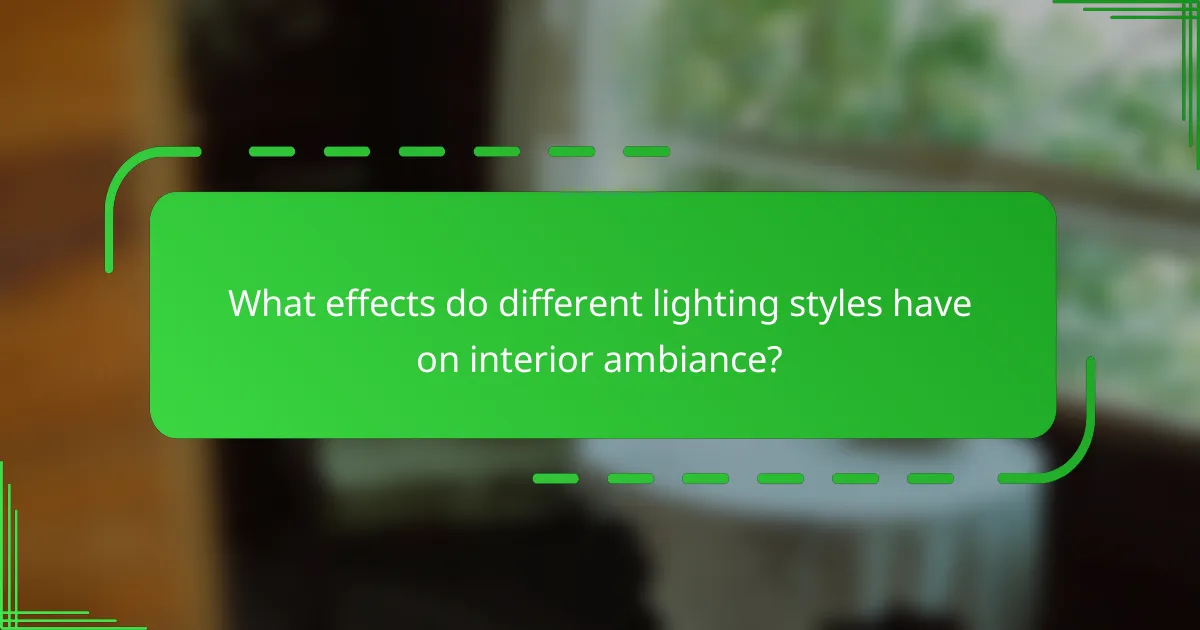Lighting is a critical element in interior design that significantly impacts mood, functionality, and aesthetics. It includes three primary types: ambient lighting, which provides overall illumination; task lighting, designed for specific activities; and accent lighting, which highlights features or decor. Proper placement of these lighting types can enhance emotional responses and improve usability, with studies indicating that effective lighting design can boost productivity and well-being. Additionally, the direction and color temperature of lighting influence spatial perception and human behavior, making thoughtful lighting choices essential for creating desired interior experiences.

What is the importance of lighting in interior spaces?
Lighting is crucial in interior spaces as it affects mood, functionality, and aesthetics. Proper lighting enhances the usability of a space by providing adequate illumination for tasks. It influences emotional responses, with warm lighting creating a cozy atmosphere and bright lighting promoting alertness. Additionally, lighting can highlight architectural features and decor, enhancing visual appeal. According to the American Society of Interior Designers, effective lighting design can increase productivity and well-being. Studies show that well-lit environments can reduce eye strain and improve overall comfort. Thus, lighting plays a vital role in shaping the experience within interior spaces.
How does lighting influence mood and ambiance?
Lighting directly influences mood and ambiance by affecting how individuals perceive their environment. Bright lighting typically enhances alertness and energy levels. Conversely, dim lighting creates a relaxing and intimate atmosphere. Color temperature also plays a crucial role; warm light promotes comfort, while cool light can enhance focus. Research indicates that specific lighting can trigger emotional responses. For example, a study published in the Journal of Environmental Psychology found that warm lighting can evoke feelings of happiness and comfort. Thus, the choice of lighting is essential for setting the desired mood and ambiance in any space.
What psychological effects does lighting have on individuals?
Lighting significantly affects individuals’ psychological states. Bright lighting often enhances alertness and energy levels. Conversely, dim lighting can create a calming or relaxing atmosphere. Studies show that natural light exposure can improve mood and reduce stress. Artificial lighting can influence emotions through color temperature; warm tones evoke comfort, while cool tones can stimulate productivity. Poor lighting conditions may lead to feelings of fatigue and irritability. Research indicates that well-designed lighting can improve focus and cognitive performance. Thus, lighting plays a crucial role in influencing psychological well-being.
How can lighting enhance or detract from a room’s aesthetic?
Lighting can significantly enhance or detract from a room’s aesthetic. Proper lighting creates a warm and inviting atmosphere. It highlights architectural features and decor. For example, accent lighting can draw attention to artwork. In contrast, harsh or dim lighting can create an unwelcoming feel. Studies show that rooms with well-balanced lighting improve mood and productivity. The right color temperature affects how colors appear in a space. Warm light enhances cozy environments, while cool light can energize a room. Overall, lighting plays a crucial role in defining a room’s visual appeal.
Why is understanding different types of lighting essential?
Understanding different types of lighting is essential for creating effective and appealing environments. Each type of lighting serves a specific purpose, influencing mood, functionality, and aesthetics. For example, ambient lighting provides overall illumination, while task lighting focuses on specific areas for activities like reading or cooking. Accent lighting highlights particular features, enhancing visual interest. Studies show that appropriate lighting can improve productivity by up to 20% in workspaces. Additionally, different color temperatures affect perceived warmth and comfort, impacting emotional responses. Proper understanding allows designers and homeowners to optimize spaces for both practicality and ambiance.
What are the main categories of lighting?
The main categories of lighting are ambient, task, and accent lighting. Ambient lighting provides overall illumination for a space. It sets the mood and creates a comfortable environment. Task lighting focuses on specific areas for activities like reading or cooking. It enhances visibility and reduces strain. Accent lighting highlights particular features or objects, such as artwork or architectural details. Each category serves a distinct purpose in enhancing interior ambiance.
How do these categories serve different purposes in interior design?
Lighting categories in interior design serve distinct purposes. Ambient lighting provides overall illumination. It ensures spaces are adequately lit for general activities. Task lighting focuses on specific areas for activities like reading or cooking. This category enhances functionality and safety. Accent lighting highlights particular features or decor elements. It creates visual interest and depth in a room. Each category contributes to the overall ambiance and usability of a space. Properly applied, these categories improve both aesthetics and practicality in interior environments.

What types of lighting are commonly used in interiors?
Common types of lighting used in interiors include ambient, task, and accent lighting. Ambient lighting provides overall illumination for a space. It is often achieved through ceiling fixtures, chandeliers, or wall-mounted lights. Task lighting focuses on specific areas for activities like reading or cooking. This type is typically provided by table lamps, under-cabinet lights, or pendant lights. Accent lighting highlights particular features or objects, such as artwork or architectural details. This is commonly done with spotlights or track lighting. Each lighting type serves a distinct purpose and contributes to the overall ambiance of an interior space.
What are the characteristics of ambient lighting?
Ambient lighting provides overall illumination in a space. It creates a soft, diffused light that reduces harsh shadows. This type of lighting enhances visibility without overwhelming brightness. Ambient lighting is typically achieved through ceiling fixtures, wall sconces, or floor lamps. It is essential for setting the mood and atmosphere in a room. The color temperature of ambient lighting often ranges from warm to neutral tones. This lighting is crucial for functional areas, allowing for comfortable movement and activities. Studies show that well-designed ambient lighting positively impacts mood and well-being.
How does ambient lighting create a foundational atmosphere?
Ambient lighting creates a foundational atmosphere by providing uniform illumination throughout a space. This type of lighting sets the overall tone and mood of an environment. It enhances visibility without harsh shadows, making areas feel more inviting. Studies show that well-distributed light can improve comfort and reduce eye strain. For instance, a study by the Lighting Research Center found that proper ambient lighting can enhance productivity in workspaces. Additionally, ambient lighting can highlight architectural features and create a sense of depth in rooms. Overall, its role is crucial in establishing a cohesive and pleasant atmosphere.
What are common sources of ambient lighting?
Common sources of ambient lighting include ceiling fixtures, wall sconces, and floor lamps. Ceiling fixtures provide widespread illumination in a room. They often use incandescent, fluorescent, or LED bulbs. Wall sconces offer indirect light that enhances the atmosphere. Floor lamps can be positioned anywhere to create a cozy environment. Natural light from windows also serves as a significant source of ambient lighting. These sources collectively contribute to the overall brightness and mood of a space.
What role does task lighting play in interior spaces?
Task lighting provides focused illumination for specific activities in interior spaces. It enhances visibility and reduces eye strain during tasks such as reading, writing, or cooking. Proper task lighting increases productivity and comfort. It can be achieved through desk lamps, under-cabinet lights, or adjustable fixtures. Studies show that adequate task lighting can improve performance and efficiency. For example, a well-lit workspace can boost concentration by up to 20%. Task lighting complements ambient lighting, creating a balanced and functional environment.
How can task lighting improve functionality in a room?
Task lighting improves functionality in a room by providing focused illumination for specific tasks. It enhances visibility, reducing eye strain during activities like reading or cooking. Proper task lighting increases productivity by allowing users to work efficiently. It can also create a more organized space by clearly defining work areas. According to the American Society of Interior Designers, well-placed task lighting can improve overall room usability. This targeted approach to lighting supports better performance and comfort in various settings.
What are effective examples of task lighting solutions?
Effective examples of task lighting solutions include desk lamps, under-cabinet lighting, and floor lamps. Desk lamps provide focused light for reading or writing. Under-cabinet lighting illuminates countertops in kitchens for food preparation. Floor lamps can be positioned next to seating areas for reading. These solutions enhance visibility and reduce eye strain. According to the American Optometric Association, proper task lighting can improve productivity and comfort in workspaces.
What is accent lighting and why is it important?
Accent lighting is a type of lighting designed to highlight specific features or objects within a space. It creates visual interest and draws attention to artwork, architectural details, or decorative elements. Accent lighting enhances the overall aesthetic of a room by adding depth and dimension. It is important because it can transform a standard space into a more inviting and engaging environment. Studies show that effective use of accent lighting can improve mood and perception of space. Properly placed accent lights can also create focal points, guiding the viewer’s eye to desired areas. This type of lighting is essential for achieving a well-balanced and harmonious interior ambiance.
How does accent lighting highlight specific features?
Accent lighting emphasizes specific features in a space by directing focused light onto them. This technique creates contrast between illuminated areas and the surrounding environment. By using adjustable fixtures, such as spotlights or wall sconces, designers can highlight artwork, architectural details, or decorative objects. The intensity and color of the light can also enhance the visual appeal of the highlighted features. For instance, warm light can create a cozy atmosphere, while cool light can add a modern touch. Proper placement of accent lighting can draw the eye and create focal points within a room. According to the American Society of Interior Designers, effective use of accent lighting can significantly enhance the overall aesthetic of a space.
What techniques can be used to implement accent lighting?
Techniques to implement accent lighting include using spotlights, wall sconces, and track lighting. Spotlights focus light on specific objects or areas, enhancing their visibility. Wall sconces provide ambient light while highlighting architectural features. Track lighting allows flexibility in directing light to various points in a room. Additionally, using LED strips can create a subtle glow along shelves or under cabinets. Dimmer switches can adjust the intensity of accent lighting, allowing for mood variation. Layering different types of accent lighting creates depth and visual interest in a space. These techniques are widely used in interior design to enhance aesthetic appeal and functionality.

How does lighting placement affect interior ambiance?
Lighting placement significantly influences interior ambiance. Properly placed lighting can enhance mood and functionality in a space. For example, ambient lighting creates a warm and inviting atmosphere. Task lighting, positioned over work areas, improves visibility and efficiency. Accent lighting highlights artwork or architectural features, adding depth and interest.
Research shows that lighting can affect emotions and behaviors. A study published in the Journal of Environmental Psychology found that warm light promotes relaxation, while cooler light increases alertness. Additionally, the direction of light impacts shadows and spatial perception.
Overall, thoughtful lighting placement is essential for creating desired interior experiences.
What factors should be considered when placing lighting fixtures?
Consider the room’s purpose when placing lighting fixtures. Different activities require varying light levels. For instance, task lighting is essential for workspaces. Ambient lighting creates a comfortable atmosphere in living areas. Analyze the fixture’s brightness and color temperature. Warmer tones are suitable for relaxation, while cooler tones enhance focus. Evaluate the layout and dimensions of the space. Proper placement reduces shadows and glare. Also, consider the fixture’s height and angle for optimal light distribution. Finally, energy efficiency is crucial. LED fixtures consume less power and have longer lifespans.
How does the height of light fixtures impact the overall effect?
The height of light fixtures significantly influences the overall effect of illumination in a space. Properly positioned fixtures enhance the ambiance by creating desired light levels. For instance, fixtures hung too high may result in insufficient light spread, leading to dark areas. Conversely, fixtures placed too low can create harsh shadows and glare. The recommended height for pendant lights is typically 30 to 36 inches above a table. This height ensures adequate illumination while maintaining visual comfort. Additionally, the height can affect the perception of room dimensions. Lower fixtures can make a space feel cozier, while higher fixtures can create an airy effect. Studies show that lighting height impacts mood and functionality in interior design.
What is the significance of light direction in creating ambiance?
Light direction significantly impacts the ambiance of a space. It affects mood, perception, and functionality. Different angles of light create varied effects. For instance, overhead lighting can make a room feel spacious. Conversely, low-angle lighting can create intimacy and warmth. Directional lighting highlights specific areas or objects, drawing attention where needed. Studies show that lighting direction influences emotional responses. Properly directed light can enhance architectural features and decor. This interplay between light direction and ambiance is crucial in interior design.
How can lighting placement enhance different areas of a room?
Lighting placement can enhance different areas of a room by creating focal points and influencing mood. Properly placed lighting can highlight artwork or architectural features, drawing attention to them. Task lighting, such as desk lamps, improves functionality in work areas. Ambient lighting creates a warm atmosphere, making spaces feel inviting. Accent lighting adds depth and dimension, enhancing visual interest. Studies show that well-lit environments can improve productivity and well-being. For example, a 2019 study in the Journal of Environmental Psychology found that natural light significantly boosts mood and performance. Thus, strategic lighting placement is essential for optimizing room functionality and ambiance.
What are the best practices for lighting living spaces?
The best practices for lighting living spaces include layering different light sources, using natural light, and considering the purpose of each area. Layering light involves combining ambient, task, and accent lighting to create a balanced environment. Natural light should be maximized by using sheer curtains and strategically placing mirrors. Each area should have lighting that suits its function, such as bright task lighting in workspaces and soft ambient lighting in relaxation areas. Additionally, the color temperature of bulbs should be chosen to match the mood; warmer tones create a cozy atmosphere while cooler tones promote focus. These practices enhance both functionality and aesthetic appeal in living spaces.
How can lighting be optimized in workspaces for productivity?
Lighting can be optimized in workspaces for productivity by utilizing natural light and adjustable artificial lighting. Natural light has been shown to enhance mood and energy levels, leading to increased productivity. Positioning workspaces near windows maximizes exposure to daylight. Adjustable artificial lighting allows employees to customize their environment based on tasks. For example, bright, cool lighting is beneficial for focus, while warmer tones can create a relaxed atmosphere. Studies indicate that proper lighting can reduce eye strain and fatigue, improving overall work performance. Implementing a combination of ambient, task, and accent lighting can cater to different activities and preferences.
What are common mistakes to avoid in lighting placement?
Common mistakes to avoid in lighting placement include improper layering of light sources. Failing to combine ambient, task, and accent lighting can lead to inadequate illumination. Another mistake is placing lights too high or too low, which affects the distribution of light. Overlooking the purpose of each room can result in inappropriate lighting choices. Ignoring the color temperature of bulbs can create an uninviting atmosphere. Additionally, not considering the direction of light can cause glare or shadows. Finally, neglecting to dim lights or use adjustable fixtures can limit flexibility in lighting design. These mistakes can significantly impact the overall ambiance of a space.
How can improper lighting placement affect functionality?
Improper lighting placement can significantly hinder functionality in a space. It can create shadows that obstruct visibility, making tasks difficult. Insufficient lighting can lead to eye strain, affecting comfort and productivity. Conversely, overly bright light can cause glare, distracting users. Specific areas may remain poorly lit, leading to accidents or injuries. Studies show that optimal lighting improves focus and efficiency. The right placement enhances mood and reduces fatigue, promoting overall well-being. Thus, proper lighting placement is essential for effective functionality in any environment.
What are the visual pitfalls of poor lighting design?
Poor lighting design creates visual pitfalls such as inadequate visibility and harsh shadows. Inadequate visibility can lead to difficulty in performing tasks, which can affect safety and productivity. Harsh shadows can distort the perception of space and create an uncomfortable atmosphere. Poor color rendering can also occur, leading to colors appearing dull or inaccurate. This can negatively impact the aesthetic appeal of a space. Glare from improperly placed light sources can cause eye strain and discomfort. Additionally, uneven lighting can create hotspots and dark areas, disrupting the visual balance of a room. These pitfalls collectively diminish the overall functionality and ambiance of an interior environment.

What effects do different lighting styles have on interior ambiance?
Different lighting styles significantly affect interior ambiance. Ambient lighting creates a soft and inviting atmosphere. It provides general illumination and enhances comfort. Task lighting focuses on specific areas, improving functionality and visibility. Accent lighting highlights particular features, adding depth and interest. Each style can evoke different emotions and set the mood of a space. For example, warm tones promote relaxation, while cooler tones can energize. Studies show that lighting influences human behavior and mood, impacting productivity and well-being. Properly combined, these styles enhance both aesthetics and functionality in interior design.
How do color temperatures influence the perception of space?
Color temperatures significantly influence the perception of space. Warmer color temperatures, typically between 2700K and 3000K, create a cozy and inviting atmosphere. This warmth can make spaces feel smaller and more intimate. Cooler color temperatures, ranging from 4000K to 6500K, evoke a sense of openness and clarity. These cooler tones can make areas appear larger and more spacious.
Research indicates that lighting color can affect mood and spatial perception. A study published in the Journal of Environmental Psychology found that warmer light enhances feelings of comfort. Conversely, cooler light is associated with increased alertness and spaciousness. Thus, the choice of color temperature can be strategically used in design to manipulate how individuals perceive size and ambiance in a space.
What are the differences between warm and cool lighting?
Warm lighting has a yellowish tone, while cool lighting has a bluish tone. Warm lighting typically ranges from 2700K to 3000K on the Kelvin scale. It creates a cozy and inviting atmosphere. Cool lighting, on the other hand, ranges from 3500K to 5000K. It promotes alertness and enhances concentration. Warm lighting is often used in residential settings. Cool lighting is commonly found in offices and workspaces. The choice between warm and cool lighting affects mood and functionality in a space.
How can color temperature be used to create specific atmospheres?
Color temperature can be used to create specific atmospheres by influencing the emotional response of individuals in a space. Warmer color temperatures, ranging from 2700K to 3000K, evoke feelings of comfort and coziness. These temperatures are ideal for residential spaces like living rooms and bedrooms. Cooler color temperatures, between 4000K and 5000K, promote alertness and focus. They are suitable for workspaces and kitchens.
Research shows that lighting affects mood and productivity. A study by the Lighting Research Center found that cooler light enhances cognitive performance. Conversely, warmer light can reduce stress and enhance relaxation. Therefore, selecting the appropriate color temperature is crucial for achieving desired atmospheres in interior design.
What impact does lighting intensity have on room dynamics?
Lighting intensity significantly affects room dynamics. It influences mood, perception of space, and functionality. High lighting intensity can create an energetic atmosphere. It enhances focus and productivity in workspaces. Conversely, low lighting intensity fosters relaxation and comfort. It is often preferred in living areas and bedrooms. Studies show that adequate lighting improves cognitive performance. For instance, a study by the American Society of Interior Designers found that proper lighting increases satisfaction in work environments. Therefore, adjusting lighting intensity can effectively alter the dynamics of a room.
How can varying light levels affect mood and activity?
Varying light levels significantly affect mood and activity. Bright light can enhance alertness and energy levels. It stimulates the production of serotonin, a hormone linked to mood elevation. Conversely, dim lighting often promotes relaxation and calmness. It encourages the production of melatonin, aiding in sleepiness. Research indicates that exposure to natural light improves overall well-being. A study by the University of Alberta found that individuals exposed to bright light reported higher energy and better mood states. In contrast, low light environments can lead to feelings of lethargy and sadness. Adjusting light levels can thus be a powerful tool for influencing emotional states and productivity.
What are the benefits of dimmable lighting solutions?
Dimmable lighting solutions provide flexibility in adjusting light intensity. This adaptability enhances mood and ambiance in various settings. Users can create a cozy atmosphere for relaxation or bright illumination for tasks. Energy savings are another significant benefit; lower brightness reduces electricity consumption. Studies indicate that dimming lights can extend bulb lifespan, resulting in fewer replacements. Additionally, dimmable lighting supports circadian rhythms by allowing users to mimic natural light patterns. This can improve sleep quality and overall well-being. The versatility of dimmable solutions makes them ideal for residential and commercial spaces alike.
How can layered lighting enhance the overall ambiance?
Layered lighting enhances overall ambiance by combining different light sources to create depth and interest. This approach includes ambient, task, and accent lighting. Ambient lighting provides general illumination, setting the mood of the space. Task lighting focuses on specific activities, ensuring functionality. Accent lighting highlights architectural features or artwork, adding visual appeal.
Research shows that well-designed layered lighting can improve mood and productivity. A study by the Lighting Research Center found that spaces with multiple light sources are perceived as more inviting and comfortable. Layered lighting also allows for flexibility in adjusting the atmosphere for different occasions. By controlling light intensity and direction, one can create various settings, from cozy to energizing.
What is the concept of layered lighting in interior design?
Layered lighting in interior design refers to the strategic combination of different types of lighting. This approach enhances the functionality and aesthetic of a space. It typically includes ambient, task, and accent lighting. Ambient lighting provides overall illumination. Task lighting focuses on specific areas for activities like reading or cooking. Accent lighting highlights particular features or decor elements. This concept improves the versatility of a room. It allows for adjustments based on time of day and mood. Layered lighting creates depth and visual interest in interior spaces.
How can different lighting types be combined for optimal effect?
Different lighting types can be combined for optimal effect by layering ambient, task, and accent lighting. Ambient lighting provides overall illumination and sets the mood. Task lighting focuses on specific areas for activities like reading or cooking. Accent lighting highlights artwork or architectural features.
Using a combination creates depth and flexibility in a space. For example, a living room can have ceiling-mounted ambient lights, table lamps for task lighting, and wall sconces for accent lighting. This approach enhances functionality and aesthetic appeal.
Research indicates that well-lit environments improve mood and productivity. A study by the Lighting Research Center shows that proper lighting can increase focus and reduce eye strain. Therefore, combining different types of lighting effectively supports both ambiance and utility.
What practical tips can improve lighting in interior spaces?
To improve lighting in interior spaces, utilize a combination of natural and artificial light. Maximize natural light by using sheer curtains and placing mirrors strategically. Choose light fixtures that complement the room’s design and provide adequate brightness. Use layered lighting, incorporating ambient, task, and accent lights for versatility. Adjust the color temperature of bulbs to create the desired mood; warmer tones promote relaxation while cooler tones enhance focus. Regularly clean light fixtures and windows to maintain brightness. Consider dimmers to control light intensity based on the time of day and activities. These tips enhance functionality and aesthetic appeal, making spaces more inviting and comfortable.
How can one select the right lighting fixtures for a space?
To select the right lighting fixtures for a space, consider the room’s function and design. Different spaces require different lighting styles. For example, kitchens benefit from bright, focused lighting, while living rooms can use softer, ambient light. Assess the size of the space; larger areas may need multiple fixtures for even illumination. Evaluate the existing decor to ensure fixtures complement the overall aesthetic. Consider energy efficiency; LED fixtures consume less energy and have longer lifespans. Determine the fixture’s height and placement to avoid glare and ensure adequate coverage. Finally, explore adjustable options for versatility in lighting intensity and direction.
What are the best practices for maintaining effective lighting?
Regularly clean light fixtures to ensure maximum brightness. Dust and dirt can significantly reduce light output. Replace burnt-out bulbs promptly to maintain consistent illumination. Use appropriate wattage as specified for each fixture to avoid overheating. Install dimmer switches for adjustable lighting levels, enhancing versatility. Consider using LED bulbs for energy efficiency and longer lifespan. Assess lighting placement to eliminate dark spots and ensure even distribution. Utilize natural light where possible to reduce reliance on artificial sources.
The main entity of the article is lighting, specifically its importance in interior spaces. The article provides a comprehensive overview of different types of lighting—ambient, task, and accent—and their roles in enhancing mood, functionality, and aesthetics. It discusses the psychological effects of lighting, the significance of proper placement, and the impact of color temperature and intensity on ambiance. Additionally, the article outlines best practices for lighting design and maintenance to optimize interior environments for comfort and productivity.

What is the importance of lighting in interior spaces?
Lighting is crucial in interior spaces as it affects mood, functionality, and aesthetics. Proper lighting enhances the usability of a space by providing adequate illumination for tasks. It influences emotional responses, with warm lighting creating a cozy atmosphere and bright lighting promoting alertness. Additionally, lighting can highlight architectural features and decor, enhancing visual appeal. According to the American Society of Interior Designers, effective lighting design can increase productivity and well-being. Studies show that well-lit environments can reduce eye strain and improve overall comfort. Thus, lighting plays a vital role in shaping the experience within interior spaces.
How does lighting influence mood and ambiance?
Lighting directly influences mood and ambiance by affecting how individuals perceive their environment. Bright lighting typically enhances alertness and energy levels. Conversely, dim lighting creates a relaxing and intimate atmosphere. Color temperature also plays a crucial role; warm light promotes comfort, while cool light can enhance focus. Research indicates that specific lighting can trigger emotional responses. For example, a study published in the Journal of Environmental Psychology found that warm lighting can evoke feelings of happiness and comfort. Thus, the choice of lighting is essential for setting the desired mood and ambiance in any space.
What psychological effects does lighting have on individuals?
Lighting significantly affects individuals’ psychological states. Bright lighting often enhances alertness and energy levels. Conversely, dim lighting can create a calming or relaxing atmosphere. Studies show that natural light exposure can improve mood and reduce stress. Artificial lighting can influence emotions through color temperature; warm tones evoke comfort, while cool tones can stimulate productivity. Poor lighting conditions may lead to feelings of fatigue and irritability. Research indicates that well-designed lighting can improve focus and cognitive performance. Thus, lighting plays a crucial role in influencing psychological well-being.
